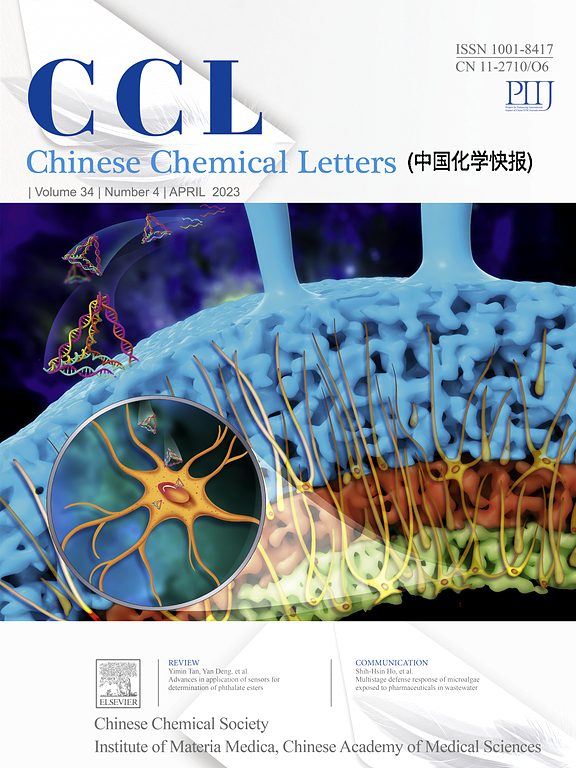具有增强磁性和导电性的卤素自由基键合有机骨架的构建
IF 9.4
1区 化学
Q1 CHEMISTRY, MULTIDISCIPLINARY
引用次数: 0
摘要
具有自由基骨架的有机骨架的发展是必要的。在这项研究中,我们报道了一种新的二维自由基卤素键合有机骨架(XOF)的发展。通过苯并咪唑与苯并咪唑自由基的偶联,合成了苯并咪唑三苯基甲基(BTTM)自由基单体。最初,苯并咪唑单元与Ag +离子配合,形成[N···Ag··N]+框架。随后,碘的加入导致Ag +在原位被I +离子取代,形成[N···I··N]+连接体,形成XOF结构。通过PXRD, HR-TEM, SEAD和SAXS分析证实,XOF-HBTTM和XOF-BTTM结构具有良好的结晶度。EPR测量证实了XOF框架内自由基特征的保存。此外,SQUID测量表明,XOF-BTTM在2 K下的自旋矩为S = 1/2,饱和磁化强度峰值为4.10 emu/g,与BTTM单体的1.87 emu/g相比有显著提高。这种磁性的改善归因于扩展的自旋密度分布和[N···I··N]+相互作用的存在,正如DFT计算所表明的那样。此外,自由基XOF-BTTM表现出显著增强的导电性,达到1.30 × 10⁻⁴S/cm,比XOF-HBTTM高两个数量级。这种增加的电导率与减少的HOMO-LUMO间隙,更高的载流子密度以及在框架内加入三苯基甲基自由基有关。本研究强调了苯并咪唑基基在构建功能性XOFs中的潜力,并促进了我们对自由基有机框架的理解。本文章由计算机程序翻译,如有差异,请以英文原文为准。
Construction of radical halogen-bonded organic frameworks with enhanced magnetism and conductivity
The development of organic frameworks with radical skeletons is desired. In this study, we report the development of a novel two-dimensional radical halogen-bonded organic framework (XOF). The radical monomer, benzimidazole triphenylmethyl (BTTM), was synthesized through the coupling of TTM radicals with benzimidazole. Initially, the benzimidazole units were coordinated with Ag⁺ ions to create a [N···Ag···N]+ framework. Subsequently, the addition of iodine led to the in situ replacement of Ag⁺ with I⁺ ions, forming [N···I···N]+ linkers and resulting in the creation of the XOF structure. The resulting XOF-HBTTM and XOF-BTTM structures demonstrated good-crystallinity, confirmed by PXRD, HR-TEM, SEAD, and SAXS analyses. EPR measurements confirmed the preservation of radical characteristics within the XOF framework. Furthermore, SQUID measurements indicated that XOF-BTTM exhibits spin moments of S = 1/2 at 2 K, with a saturated magnetization strength peaking at 4.10 emu/g, a notable enhancement compared to 1.87 emu/g for the BTTM monomer. This improvement in magnetism is attributed to the extended spin density distribution and the presence of [N···I···N]+ interactions, as suggested by DFT calculations. Additionally, the radical XOF-BTTM exhibited significantly enhanced electrical conductivity, reaching up to 1.30 × 10⁻⁴ S/cm, which is two orders of magnitude higher than that of XOF-HBTTM. This increased conductivity is linked to a reduced HOMO-LUMO gap, higher carrier density, and the incorporation of triphenylmethyl radicals within the framework. This research highlights the potential of benzimidazolyl motifs in constructing functional XOFs and advances our understanding of radical organic frameworks.
求助全文
通过发布文献求助,成功后即可免费获取论文全文。
去求助
来源期刊

Chinese Chemical Letters
化学-化学综合
CiteScore
14.10
自引率
15.40%
发文量
8969
审稿时长
1.6 months
期刊介绍:
Chinese Chemical Letters (CCL) (ISSN 1001-8417) was founded in July 1990. The journal publishes preliminary accounts in the whole field of chemistry, including inorganic chemistry, organic chemistry, analytical chemistry, physical chemistry, polymer chemistry, applied chemistry, etc.Chinese Chemical Letters does not accept articles previously published or scheduled to be published. To verify originality, your article may be checked by the originality detection service CrossCheck.
 求助内容:
求助内容: 应助结果提醒方式:
应助结果提醒方式:


